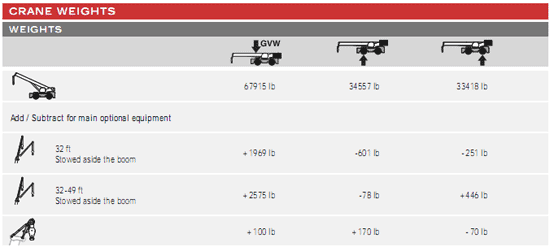Crane
Mobile Crane
Load Charts of Crane
Every crane has a load chart that specifies the crane’s capabilities. This chart includes feature of the crane and how its lift capacity varies when considering distance and angle. Before buying, renting, and employing a crane load chart of crane should be reviewed in order to determine whether it is appropriate crane for the job or not.
Here, we ought to know how to read a crane chart. I have chosen the chart for the Terex RT345XL, a rough terrain crane with maximum lift capacity of 45 tons to illustrate how a crane chart can be read.
1. Dimensions and Weight
The chart shows the crane dimensions. It includes information for operation with outriggers extended, transport weight, and steering dimensions. Knowing this information is necessary and critical especially when crane will be working in a confined space, as the lifting capacity varies depending on whether the outriggers are extended.

The transport weight shows the trailer to be used, how to load the crane on the trailer, the route to take, and what permits are required to get it to the jobsite.

2. Lifiting Capacity
In the legend at the top of the chart, you can see these ratings apply when using 6.5 tons of counterweight, with the outriggers extended to 22 x 22.3 feet. Here, you'd graph out the specific lift the crane is needed for. The 'ft.' indicator on the left axis represents the radius, the distance from the center pin to the center of the load.
For example: You need to lift a load of 15 tons (30,000 pounds) a distance of 25 feet. The distance is measured from the center pin of the crane to the center of the load. Once you determine the distance, look on that line for the largest capacity; that will indicate how many feet of boom must be extended. In this case, it is 45 feet.

It's important to know that the maximum capacity is always measured by the shortest lift, usually over the rear of the crane, and with the outriggers fully extended. Lifts at any distance or height drops the maximum capacity dramatically.
3. Lift Range
Lift range is also important. This chart illustrates how much boom length is needed in order to lift a load both at height and a distance.
For example: You need to pick up a load at 25 feet and lift it to the top of a five-story, 65-foot building. Consulting the range diagram, 69 feet of boom is required to make the lift.

4. Lift Angle
This chart shows the maximum lift if a luffing or fixed jib is used. Lifts with jib lengths of 32 and 49 feet (in addition to boom extension of 105 feet) are shown. It is obvious that with higher angles of lift, the maximum load capacity decreases. With a luffing jib, the angle can be automatically adjusted from the operators cab.

5. Crane In Motion
This shows the lift capacity of crane for a pick and carry. The chart illustrates how much weight crane can pick up at a 360-degree angle while stationary on wheels, the total weight being able to be supported both while slowly rolling with the load at a zero degree angle (creep), and the total weight able to be supported while moving at 2.5 miles per hour. The column to the left again indicates the radius of the lift. The column on the right shows the maximum boom length each weight can be carried at.
